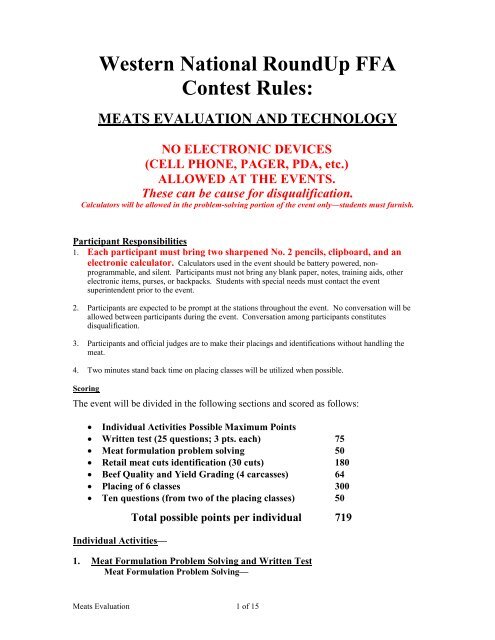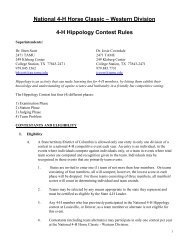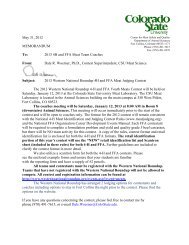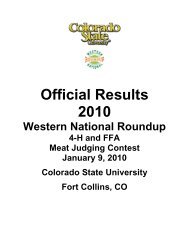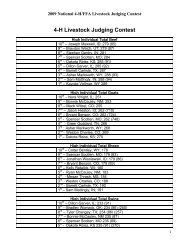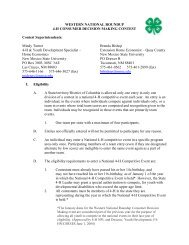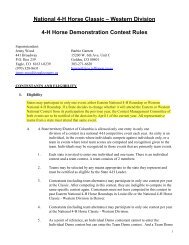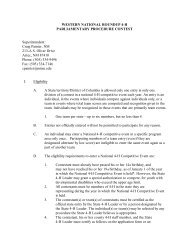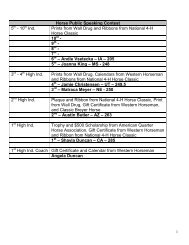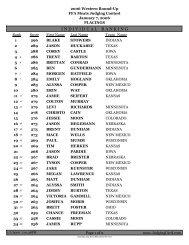Jan 2014 Complete Meat Contest, 4-H and FFA Rules. - Western ...
Jan 2014 Complete Meat Contest, 4-H and FFA Rules. - Western ...
Jan 2014 Complete Meat Contest, 4-H and FFA Rules. - Western ...
Create successful ePaper yourself
Turn your PDF publications into a flip-book with our unique Google optimized e-Paper software.
<strong>Western</strong> National RoundUp <strong>FFA</strong><br />
<strong>Contest</strong> <strong>Rules</strong>:<br />
MEATS EVALUATION AND TECHNOLOGY<br />
NO ELECTRONIC DEVICES<br />
(CELL PHONE, PAGER, PDA, etc.)<br />
ALLOWED AT THE EVENTS.<br />
These can be cause for disqualification.<br />
Calculators will be allowed in the problem-solving portion of the event only—students must furnish.<br />
Participant Responsibilities<br />
1. Each participant must bring two sharpened No. 2 pencils, clipboard, <strong>and</strong> an<br />
electronic calculator. Calculators used in the event should be battery powered, nonprogrammable,<br />
<strong>and</strong> silent. Participants must not bring any blank paper, notes, training aids, other<br />
electronic items, purses, or backpacks. Students with special needs must contact the event<br />
superintendent prior to the event.<br />
2. Participants are expected to be prompt at the stations throughout the event. No conversation will be<br />
allowed between participants during the event. Conversation among participants constitutes<br />
disqualification.<br />
3. Participants <strong>and</strong> official judges are to make their placings <strong>and</strong> identifications without h<strong>and</strong>ling the<br />
meat.<br />
4. Two minutes st<strong>and</strong> back time on placing classes will be utilized when possible.<br />
Scoring<br />
The event will be divided in the following sections <strong>and</strong> scored as follows:<br />
• Individual Activities Possible Maximum Points<br />
• Written test (25 questions; 3 pts. each) 75<br />
• <strong>Meat</strong> formulation problem solving 50<br />
• Retail meat cuts identification (30 cuts) 180<br />
• Beef Quality <strong>and</strong> Yield Grading (4 carcasses) 64<br />
• Placing of 6 classes 300<br />
• Ten questions (from two of the placing classes) 50<br />
Individual Activities—<br />
Total possible points per individual 719<br />
1. <strong>Meat</strong> Formulation Problem Solving <strong>and</strong> Written Test<br />
<strong>Meat</strong> Formulation Problem Solving—<br />
<strong>Meat</strong>s Evaluation 1 of 15
Students will complete a meat formulation problem solving exercise. An example is at the end of<br />
this section. Nine questions are to be answered using the computerized scorecard. The one<br />
solution to the meat formulation problem will be worth 10 points. The other 8 questions based on<br />
the correct formulation will be valued at 5 points each.<br />
Written Exam -<br />
Each participant will be given a written test relating to meat storage <strong>and</strong> h<strong>and</strong>ling, cookery,<br />
nutrition, food safety (HACCP principles, bio-security <strong>and</strong> personal safety), animal welfare <strong>and</strong><br />
animal identification systems. Questions could include multiple choice, true/false or situation<br />
based questions. Value per question will be based on question type. Maximum points possible on<br />
the exam is 80 points. All questions will be based on materials taken from the “<strong>Meat</strong> Science <strong>and</strong><br />
Food Safety” DVD available through CEV Multimedia as listed on the resource material list.<br />
Identified chapters of the DVD will be publicized for the written exam.<br />
CEV Multimedia<br />
1020 SE Loop 289, Lubbock, TX 79404, (800) 922-9965<br />
• Retail Cuts Identification (DVD)<br />
• <strong>Meat</strong> Science <strong>and</strong> Food Safety (DVD) - written exam resource<br />
2. Retail <strong>Meat</strong> Cuts Identification<br />
Participants will identify 30 retail meats cuts found on the “<strong>Meat</strong>s Identification Card.”<br />
The official key (Retail Cuts Coding) is located at the end of this chapter of the h<strong>and</strong>book.<br />
Only the cuts listed are eligible to be used in this event. Participants will be given<br />
one point for correct species identification, one point for correct primal cut identification,<br />
one point for correct cookery <strong>and</strong> three points for correct retail trade name. Answers<br />
will be recorded on a computerized scorecard.<br />
3. Beef Quality <strong>and</strong> Yield Grading<br />
Participants will quality <strong>and</strong> yield grade six beef carcasses.<br />
Quality Grading: Using Training Aid II (located at end of <strong>Meat</strong>s Evaluation section), the<br />
student may give the carcass a maturity score <strong>and</strong> a marbling score based on USDA st<strong>and</strong>ards <strong>and</strong><br />
then determine the quality grade. The student should complete the section of answers for quality<br />
grading on the computerized scorecard.<br />
Yield Grading: Using Training Aid II, students may write in the carcass weight which is<br />
given for each carcass, give the carcass a preliminary yield grade based on USDA St<strong>and</strong>ards, <strong>and</strong><br />
then adjust the preliminary yield grade using “Ribeye Area” <strong>and</strong> “% Kidney, Pelvic <strong>and</strong> Heart<br />
Fat.” After completing these steps, the student may write in the final “Yield Grade”. The student<br />
should complete the section of answers for yield grading on the computerized scorecard.<br />
A deduction of two points will be made for a one-third grade above or below the official<br />
grade; five points will be deducted for two-thirds grade above or below the official grade; eight<br />
points will be deducted for one full grade above or below the official grade. A perfect score will<br />
be sixty points for Quality grading <strong>and</strong> sixty points for Yield grading.<br />
4. Placing of Four Classes<br />
<strong>Meat</strong>s Evaluation 2 of 15
Four classes from the following list will be placed with selected placings completed on<br />
the computerized scorecard. All classes will consist of four exhibits per class.<br />
1.) Retail cuts<br />
a. Beef Chuck, Arm Roast<br />
b. Beef Rib, Rib Steak, Lip-on<br />
c. Beef Rib, Ribeye Steak<br />
d. Beef Loin, T-Bone/Porterhouse Steak<br />
e. Beef Loin, Top Loin Steak, Boneless<br />
f. Beef Loin, Top Sirloin Steak, Boneless<br />
g. Beef Round, Round Steak (Bone-In or Boneless)<br />
h. Pork Shoulder, Blade Boston Roast<br />
i. Pork Shoulder, Blade Steak<br />
j. Pork Loin, Blade Chop<br />
k. Pork Loin, Blade Roast<br />
l. Pork Loin, Rib Chop<br />
m. Pork Loin, Loin Chop<br />
n. Pork Ham, Smoked Center Slice<br />
2.) Pork carcasses<br />
3.) Wholesale/subprimal pork cuts<br />
a. Pork Fresh Hams (401*/401A)<br />
b. Pork Loins (410*/411/412*)<br />
4.) Wholesale/subprimal beef cuts<br />
a. Beef Ribs (103/107/109/112A*)<br />
b. Beef Rounds (158*/160)<br />
c. Beef Short Loins, Short-Cut (174*)<br />
d. Beef Strip Loins, Bnls (180)<br />
5. Questions on Placing of Two Classes <strong>and</strong> Ten Questions<br />
Two selected classes listed in “Individual Activities, Item 4- Placing of Four Classes”<br />
will be placed. A total of ten questions will be asked covering both classes. Answers will be<br />
transferred to the appropriate computerized scorecard. Notepaper will be provided for this<br />
section. Students will not be able to use their notes when answering questions.<br />
Sample Question: “Which beef carcass had the highest percentage of KPH fat?”<br />
<strong>Meat</strong>s Evaluation 3 of 15
EXAMPLES<br />
<strong>Meat</strong> Formulation Problem Solving <strong>and</strong> Written Test Examples<br />
Sample Questions:<br />
What is the maximum amount of fat that ground beef can contain?<br />
*A............. 30% C ................ 40%<br />
B .............. 10% D ................ 20%<br />
What is the least desirable method of thawing frozen meat?<br />
*A. Defrosting at room temperature<br />
*B. Defrosting in refrigerator<br />
*C. Defrosting in a microwave<br />
*D. Cooking from frozen state<br />
Students will be given a situational problem involving the least cost formulation of a batch of<br />
particular meat products (hamburger, wiener, bologna, etc.) This problem will be worth 50 points <strong>and</strong><br />
consist of procedural questions <strong>and</strong> the actual determination of the least cost price.<br />
Ground Beef Formulation Problem<br />
Training Materials<br />
Assume that you manage a meat plant that manufactures ground beef for a chain of<br />
retail stores. Your goal is to produce a fresh, wholesome product which complies with<br />
all meat inspection regulations <strong>and</strong> which will have three days’ shelf life in the meat<br />
case. The fat content must comply with the specifications of the stores. The cost of<br />
the product should be as low as possible. All problems will be worked to three<br />
decimal places <strong>and</strong> rounded to two places.<br />
Ground Beef Regulations (USDA)<br />
GROUND BEEF: The terms “Ground Beef” <strong>and</strong> “Chopped Beef” are synonymous.<br />
Products so labeled must be made with fresh <strong>and</strong>/or frozen beef with or without<br />
seasoning, <strong>and</strong> without the addition of fat as such, <strong>and</strong> shall contain no more than<br />
30% fat. It may contain added water, binders or extenders. It may contain beef cheek<br />
meat not to exceed 25%. Heart <strong>and</strong> tongue are not acceptable ingredients.<br />
If the name is qualified by the name of a particular cut, such as “Ground Beef Round”<br />
or “Beef Chuck, Ground” the product must consist entirely of meat from the<br />
particular cut or part.<br />
Industry Guidelines on Ground Beef Manufacture<br />
1. To get the most desirable color <strong>and</strong> maximum shelf life, all boneless meats used to<br />
manufacture ground beef shall be fresh not frozen), well chilled (temperature no<br />
higher than 35 o F), <strong>and</strong> shall arrive at the plant within 96 hours of animal<br />
slaughter.<br />
2. A least-cost determination shall be performed on acceptable meat ingredients to<br />
select those meats that produce the lowest cost product that meets all ground beef<br />
<strong>Meat</strong>s Evaluation 4 of 15
guidelines.<br />
3. To simplify the grinding <strong>and</strong> blending operation, only two meat ingredients will be<br />
used for each batch.<br />
4. Rounding of decimals -- 5-9 will be rounded up; 1-4 will be rounded down.<br />
EXAMPLE: Utilize the Pearson Square to formulate a batch of ground beef to the<br />
desired fat content.<br />
<strong>Meat</strong>s:<br />
(1) Boneless cow meat (10% fat - $.99/lb.)<br />
(2) 75% lean beef trimmings (25% fat -$.79/lb.)<br />
Desired Final Fat Content: 20%<br />
Batch Size: 1,000 lbs.<br />
Determine:<br />
a. The amounts of the two types of meat that must be blended together to give the<br />
desired fat content.<br />
b. The meat cost of the finished product.*<br />
*NOTE: You will only be determining meat costs. In an actual situation overhead<br />
cost must also be added to the cost of the ground beef to account for labor,<br />
equipment, transportation, etc. In this exercise the student need not be concerned<br />
with these overhead costs.<br />
Pearson Square<br />
(A)<br />
Fat Content<br />
of <strong>Meat</strong> 1<br />
(D)<br />
Difference Between<br />
B <strong>and</strong> C<br />
(C)<br />
Desired Fat Content<br />
of Finished Batch<br />
(B)<br />
Fat Content<br />
of <strong>Meat</strong> 2<br />
(E)<br />
Difference Between<br />
A <strong>and</strong> C<br />
Sum of (D) <strong>and</strong> (E)<br />
Proportion of ingredient (A) = (D)/(Sum)<br />
Proportion of ingredient (B) = (E)/(Sum)<br />
<strong>Meat</strong>s Evaluation 5 of 15
For Previous Information:<br />
(A)<br />
(D)<br />
Fat Content Difference Between<br />
of <strong>Meat</strong> 1<br />
B <strong>and</strong> C<br />
(A) 10% (D) 5<br />
20%<br />
(B) 25% (E) 10<br />
15 (Sum)<br />
`<br />
Proportions:<br />
(1) Boneless cow = 5/15 = 0.33<br />
(x 1000 lbs. = 330 lbs.)<br />
(2) 75% Beef trim = 10/15 = 0.67<br />
(x 1000 lbs. = 670 lbs.)<br />
Verify Final Fat Content<br />
330 lbs. x 0.10 (fat) = 33 lbs.<br />
670 lbs. x 0.25 (fat) = 167 lbs.<br />
Cost per Pound<br />
= 200 lbs. fat/<br />
= 1,000 lbs. batch<br />
= (20% fat)<br />
Boneless cow meat 0.33 x $.99/lb. = .33<br />
75% trim 0.67 x $.79/lb. = .53<br />
$.86 lb.<br />
<strong>Meat</strong>s Evaluation 6 of 15
SAMPLE PROBLEM<br />
You must follow all government regulations <strong>and</strong> company policies listed in the training materials.<br />
Determine which available ingredients to use (<strong>and</strong> at what levels) to make the lowest priced ground<br />
beef acceptable.<br />
SPECIFICATIONS:<br />
Desired fat content of finished product is 18%<br />
Batch Size = 5000 lbs.<br />
Manufacturing Date = February 10<br />
No product over 5 days old may be used.<br />
No variety meats may be used.<br />
No product over 35˚ F may be used.<br />
Boneless <strong>Meat</strong> Ingredients Available<br />
Slaughter Date Temp. Fat Content Price<br />
Bull meat February 6 33º F 8% $1.05<br />
Boneless chuck February 7 35º F 14% $1.00<br />
75% lean trim February 4 32º F 25% $0.75<br />
50% lean trim February 6 31º F 50% $0.55<br />
Beef chuck February 7 37º F 12% $0.70<br />
Beef hearts February 6 32º F 15% $0.35<br />
Solution:<br />
Do all potential ingredients meet government regulations <strong>and</strong> company<br />
specifications?<br />
Acceptable<br />
Not Acceptable<br />
Bull meat<br />
75% lean trim (too old)<br />
Boneless chuck Beef chuck (too warm)<br />
50% lean trim Beef hearts (not allowed)<br />
Therefore, to produce desired fat content, product could be made from either of the following two<br />
combinations:<br />
(1) Bull meat <strong>and</strong> 50% lean trim<br />
(2) Boneless chuck <strong>and</strong> 50% lean trim<br />
<strong>Meat</strong>s Evaluation 7 of 15
Which combination results in the lowest meat cost?<br />
(1) Bull meat 32<br />
8% fat<br />
18% fat<br />
(final)<br />
50% trim 10<br />
50% fat 42<br />
Proportions:<br />
Bull meat = 32/42 = 0.76 (3,800 lbs.)<br />
50% trim = 10/42 = 0.24 (1,200 lbs.)<br />
5,000 lbs.)<br />
Cost:<br />
Bull meat— 0.76 x $1.05 = $.798<br />
50% trim— 0.24 x $ .55 = $.132<br />
0.93 or<br />
$.93/lb.<br />
(2) Boneless chuck 32<br />
14% fat<br />
18% fat<br />
(final)<br />
50% trim 4<br />
50% fat 36<br />
50% fat<br />
Proportions:<br />
Boneless chuck = 32/36 = 0.89 (4,450 lbs.)<br />
50% trim = 4/36 = 0.11 ( 550 lbs.)<br />
5,000 lbs.)<br />
Cost:<br />
Bull meat—0.89 x $1.00 = $0.89<br />
50% trim— 0.11 x $1.55 = $0.06<br />
$0.95 or<br />
<strong>Meat</strong>s Evaluation 8 of 15
$0.95/lb<br />
Final Solution: <strong>Meat</strong>s to be used:<br />
Bull meat --- 3,800 lbs.<br />
50% trim --- 1,200 lbs.<br />
<strong>Meat</strong> Costs: $ 0.93 per pound<br />
Scoring:<br />
The answer to the formulation problem will count ten points. There will be an<br />
additional eight questions, worth five points each. To facilitate computer scoring<br />
of this exercise, the participants will be given a list of ten or more meat/price<br />
combinations, <strong>and</strong> be required to select the correct one, based upon the above<br />
calculation. Answers to the eight additional questions will be selected from four<br />
choices.<br />
Example: Check the correct solution:<br />
11. Bull <strong>and</strong> chuck meat (0.89)<br />
12. Boneless chuck <strong>and</strong> 75% lean trim (0.91)<br />
13. Bull meat <strong>and</strong> 50% lean trim (0.93)<br />
14. Boneless chuck <strong>and</strong> 50% less trim (0.90)<br />
15. Bull meat <strong>and</strong> 50% lean trim (0.88)<br />
16. Beef hearts <strong>and</strong> 75% lean trim (0.68)<br />
17. Bull meat <strong>and</strong> 50% lean trim (0.97)<br />
18. Beef chuck meat <strong>and</strong> bull meat (1.04)<br />
19. 75% lean trim <strong>and</strong> 50% lean trim (0.67)<br />
10. 50% lean trim <strong>and</strong> bull meat (0.87)<br />
Example questions: All problems will be worked to three decimal places <strong>and</strong> rounded to two places. If the<br />
third decimal is 5 or more, the number will be rounded up.<br />
1. Which ingredients do not meet company temperature constraints?<br />
Answer: Beef chuck<br />
2. Which ingredients do not meet company freshness requirements?<br />
Answer: 75% lean trim<br />
3. Which ingredients do not meet government regulations?<br />
Answer: Beef hearts<br />
<strong>Meat</strong>s Evaluation 9 of 15
REFERENCES<br />
This list of references is not intended to be inclusive. Other sources may be utilized <strong>and</strong><br />
teachers are encouraged to make use of the very best instructional materials available.<br />
The following list contains references that may prove helpful during event preparation.<br />
AMSA <strong>Meat</strong> Evaluation H<strong>and</strong>book<br />
AMSA Guide to Identifying <strong>Meat</strong> Cuts<br />
USDS Marbling Photographs<br />
Materials available from:<br />
American <strong>Meat</strong> Science Association (AMSA)<br />
1111 North Dunlap Avenue<br />
Savoy, Illinois 61874<br />
Phone: 217-356-5368<br />
Fax: 217-398-4119<br />
http://www.meatscience.org/<br />
E-mail: info@meatscience.org<br />
Beef Ribeye Grids<br />
Art Services, Inc.<br />
3015 Earl Place, N.E.<br />
Washington, D.C., 20018<br />
Phone: 202-526-5607<br />
Preliminary Yield Grade Rulers<br />
NASCO<br />
901 <strong>Jan</strong>esville Avenue<br />
P.O. Box 901<br />
Fort Atkinson, WI 53538-0901<br />
Phone: 1-800-558-9595<br />
Fax: 920-563-8296<br />
http://www.nascofa.com/prod/BrowseMinorIndex?quickkey=222&text=Measuring+Equipment&title=Agri<br />
cultural+Sciences&seqid=13<br />
<strong>Meat</strong>s Evaluation Materials<br />
CEV Multimedia<br />
P.O. Box 65265<br />
Lubbock, TX 79464<br />
Phone: 1-800-922-9965<br />
National Cattlemen’s Beef Association<br />
Customer service department for brochures <strong>and</strong> materials<br />
1-800-368-3138<br />
<strong>Meat</strong>s Evaluation 10 of 15
Retail Cut Identification Code Sheet with Cookery<br />
Species<br />
Retail Cooking<br />
Cooking<br />
Primal Cut Method Species Primal Retail Cut<br />
Method<br />
B B 89 M Beef Brisket Corned Moist<br />
B B 15 M Beef Brisket Flat Half, Bnls Moist<br />
B B 10 M Beef Brisket Whole, Bnls Moist<br />
B C 26 M Beef Chuck 7-bone Pot-Roast Moist<br />
B C 03 M Beef Chuck Arm Pot-Roast Moist<br />
B C 04 M Beef Chuck Arm Pot-Roast, Bnls Moist<br />
B C 06 M Beef Chuck Blade Roast Moist<br />
B C 13 D/M Beef Chuck Eye Roast, Bnls Dry/Moist<br />
B C 45 D Beef Chuck Eye Steak, Bnls Dry<br />
B C 20 M Beef Chuck Mock Tender Roast Moist<br />
B C 48 M Beef Chuck Mock Tender Steak Moist<br />
B C 21 D Beef Chuck Petite Tender Dry<br />
B C 29 D/M Beef Chuck Shoulder Pot Roast (Bnls) Dry/Moist<br />
B C 58 D Beef Chuck Top Blade Steak (Flat Iron) Dry<br />
B D 47 D/M Beef Flank Flank Steak Dry/Moist<br />
B F 49 D Beef Loin Porterhouse Steak Dry<br />
B F 55 D Beef Loin T-bone Steak Dry<br />
B F 34 D Beef Loin Tenderloin Roast Dry<br />
B F 56 D Beef Loin Tenderloin Steak Dry<br />
B F 59 D Beef Loin Top Loin Steak Dry<br />
B F 60 D Beef Loin Top Loin Steak, Bnls Dry<br />
B F 64 D Beef Loin Top Sirloin Cap Steak, Bnls Dry<br />
B F 63 D Beef Loin<br />
Top Sirloin Steak, Bnls Cap<br />
Off<br />
Dry<br />
B F 62 D Beef Loin Top Sirloin Steak, Bnls Dry<br />
B F 40 D Beef Loin Tri Tip Roast Dry<br />
B G 28 M Beef Plate Short Ribs Moist<br />
B G 54 D/M Beef Plate Skirt Steak, Bnls D/M<br />
B H 22 D Beef Rib Rib Roast Dry<br />
B H 13 D Beef Rib Ribeye Roast, Bnls Dry<br />
B H 45 D Beef Rib Ribeye Steak, Bnls Dry<br />
B H 50 D Beef Rib Ribeye Steak, Lip-On Dry<br />
B I 08 D/M Beef Round Bottom Round Roast Dry/Moist<br />
B I 09 D/M Beef Round Bottom Round Rump Roast Dry/Moist<br />
B I 43 M Beef Round Bottom Round Steak Moist<br />
B I 14 D/M Beef Round Eye Round Roast Dry/Moist<br />
B I 46 D/M Beef Round Eye Round Steak Dry/Moist<br />
B I 51 M Beef Round Round Steak Moist<br />
B I 52 M Beef Round Round Steak, Bnls Moist<br />
<strong>Meat</strong>s Evaluation 11 of 15
B I 36 D/M Beef Round Tip Roast - Cap Off Dry/Moist<br />
B I 57 D Beef Round Tip Steak - Cap Off Dry<br />
B I 39 D Beef Round Top Round Roast Dry<br />
B I 61 D Beef Round Top Round Steak Dry<br />
B N 82 M Beef Various Beef for Stew Moist<br />
B N 83 D/M Beef Various Cubed Steak Dry/Moist<br />
B N 84 D Beef Various Ground Beef Dry<br />
P E 44 D/M Pork Ham/Leg Pork Fresh Ham Center Slice Dry/Moist<br />
P E 25 D/M Pork Ham/Leg<br />
Pork Fresh Ham Rump<br />
Portion<br />
Dry/Moist<br />
P E 27 D/M Pork Ham/Leg<br />
Pork Fresh Ham Shank<br />
Portion<br />
Dry/Moist<br />
P E 91 D Pork Ham/Leg Smoked Ham, Bnls Dry<br />
P E 90 D Pork Ham/Leg Smoked Ham, Center Slice Dry<br />
P E 96 D Pork Ham/Leg Smoked Ham, Rump Portion Dry<br />
P E 97 D Pork Ham/Leg Smoked Ham, Shank Portion Dry<br />
P E 35 D Pork Ham/Leg Tip Roast, Bnls Dry<br />
P E 38 D Pork Ham/Leg Top Roast, Bnls Dry<br />
P F 05 D/M Pork Loin Back Ribs Dry/Moist<br />
P F 66 D/M Pork Loin Blade Chops Dry/Moist<br />
P F 67 D/M Pork Loin Blade Chops, Bnls Dry/Moist<br />
P F 06 D/M Pork Loin Blade Roast Dry/Moist<br />
P F 68 D Pork Loin Butterflied Chops Bnls Dry<br />
P F 11 D Pork Loin Center Loin Roast Dry<br />
P F 12 D Pork Loin Center Rib Roast Dry<br />
P F 69 D/M Pork Loin Country Style Ribs Dry/Moist<br />
P F 70 D Pork Loin Loin Chops Dry<br />
P F 71 D Pork Loin Rib Chops Dry<br />
P F 73 D Pork Loin Sirloin Chops Dry<br />
P F 53 D Pork Loin Sirloin Cutlets Dry<br />
P F 30 D Pork Loin Sirloin Roast Dry<br />
P F 93 D Pork Loin Smoked Pork Loin Chop Dry<br />
P F 95 D Pork Loin Smoked Pork Loin Rib Chop Dry<br />
P F 34 D Pork Loin Tenderloin, Whole Dry<br />
P F 74 D Pork Loin Top Loin Chops Dry<br />
P F 75 D Pork Loin Top Loin Chops, Bnls Dry<br />
P F 37 D Pork Loin Top Loin Roast, Bnls Dry<br />
P J 02 D/M Pork Shoulder Arm Picnic, Whole Dry/Moist<br />
P J 03 D/M Pork Shoulder Arm Roast Dry/Moist<br />
P J 41 D/M Pork Shoulder Arm Steak Dry/Moist<br />
P J 07 D/M Pork Shoulder Blade Boston Roast Dry/Moist<br />
<strong>Meat</strong>s Evaluation 12 of 15
P J 42 D/M Pork Shoulder Blade Steak Dry/Moist<br />
P J 94 D/M Pork Shoulder Smoked Picnic, Whole Dry/Moist<br />
P K 98 D Pork Side Slab Bacon Dry<br />
P K 99 D Pork Side Sliced Bacon Dry<br />
P K 17 M Pork Side/Belly Fresh Side Moist<br />
P L 32 D/M Pork Spareribs Pork Spareribs Dry/Moist<br />
P N 85 D Pork Various Ground Pork Dry<br />
P N 86 M Pork Various Hock Moist<br />
P N 83 D/M Pork Various Pork Cubed Steak Dry/Moist<br />
P N 87 D Pork Various Pork Sausage Links Dry<br />
P N 87 D Pork Various Sausage Dry<br />
P N 92 M Pork Various Smoked Pork Hock Moist<br />
L A 24 D/M Lamb Breast Ribs (Denver Style) Dry/Moist<br />
L E 01 D Lamb Leg American Style Roast Dry<br />
L E 44 D Lamb Leg Center Slice Dry<br />
L E 16 D Lamb Leg Frenched Style Roast Dry<br />
L E 18 D Lamb Leg Leg Roast, Bnls Dry<br />
L E 73 D Lamb Leg Sirloin Chops Dry<br />
L E 31 D Lamb Leg Sirloin Half Dry<br />
L F 70 D Lamb Loin Loin Chops Dry<br />
L F 19 D Lamb Loin Loin Roast Dry<br />
L H 71 D Lamb Rib Rib Chops Dry<br />
L H 72 D Lamb Rib Rib Chops Frenched Dry<br />
L H 22 D Lamb Rib Rib Roast Dry<br />
L H 23 D Lamb Rib Rib Roast, Frenched Dry<br />
L J 65 D/M Lamb Shoulder Arm Chops Dry/Moist<br />
L J 66 D/M Lamb Shoulder Blade Chops Dry/Moist<br />
L J 33 D/M Lamb Shoulder Square Cut Dry/Moist<br />
L N 88 M Lamb Various Shank Moist<br />
B M 76 D/M Beef Variety Heart Dry/Moist<br />
L M 76 D/M Lamb Variety Heart Dry/Moist<br />
P M 76 D/M Pork Variety Heart Dry/Moist<br />
B M 77 D/M Beef Variety Kidney Dry/Moist<br />
L M 77 D/M Lamb Variety Kidney Dry/Moist<br />
P M 77 D/M Pork Variety Kidney Dry/Moist<br />
B M 78 D/M Beef Variety Liver Dry/Moist<br />
L M 78 D/M Lamb Variety Liver Dry/Moist<br />
P M 78 D/M Pork Variety Liver Dry/Moist<br />
B M 79 M Beef Variety Oxtail Moist<br />
<strong>Meat</strong>s Evaluation 13 of 15
B M 80 D/M Beef Variety Tongue Dry/Moist<br />
L M 80 D/M Lamb Variety Tongue Dry/Moist<br />
P M 80 D/M Pork Variety Tongue Dry/Moist<br />
B M 81 M Beef Variety Tripe Moist<br />
<strong>Meat</strong>s Evaluation 14 of 15
Carcass<br />
NO. Est. Adj.<br />
1<br />
2<br />
3<br />
4<br />
5<br />
6<br />
Carcass Yield Grading<br />
PYG Rib Eye Area % KPH<br />
Carcass<br />
Weight<br />
Required<br />
REA Est. Adj. Est. Adj. FYG<br />
Carcass Quality Grading<br />
Age<br />
Carcass<br />
No. Bone Lean Marbling Quality Grade<br />
1<br />
2<br />
3<br />
4<br />
5<br />
6<br />
Prime High<br />
Prime Avg.<br />
Prime Low<br />
Choice High<br />
Choice Avg.<br />
Choice Low<br />
Select High<br />
Select Low<br />
St<strong>and</strong>ard High<br />
St<strong>and</strong>ard Low<br />
Commercial High<br />
Commercial Ave.<br />
Commercial Low<br />
Utility High<br />
Utility Avg.<br />
Utility Low<br />
Place the grade in the space for "Quality<br />
Grade." Ten points are allowed for the correct<br />
grading of each carcass. A deduction of two<br />
points will be made for a one-third grade above<br />
or below the official grade; five points will be<br />
deducted for two-thirds grade above or below<br />
the official grade; eight points will be deducted<br />
for one full grade above or below the official<br />
grade; ten points will be deducted for more<br />
than one full grade above or below the official<br />
grade. Perfect score will be sixty points.<br />
Canner <strong>and</strong> Cutter grades will not be used in the event. Since maturity is a factor between<br />
St<strong>and</strong>ard <strong>and</strong> Commercial grades, carcasses which are close to the borderlines of maturity<br />
between these grades are not included in the event. There is not a Commercial grade for the<br />
carcasses from young animals; therefore, the spaces given to "Commercial" are not considered<br />
when scoring the carcasses from young animals.<br />
<strong>Meat</strong>s Evaluation 15 of 15
<strong>Rules</strong> for the <strong>Western</strong> National RoundUp 4-H<br />
<strong>Meat</strong> Evaluation <strong>Contest</strong> Taken From:<br />
National 4-H <strong>Meat</strong> Identification <strong>and</strong><br />
Judging <strong>Contest</strong> (available at<br />
www.meatjudging.org)<br />
Eligibility<br />
A. This contest is open to a team of four 4-H members from a state to be selected <strong>and</strong>/or certified by the state 4-H<br />
leader. The three high scoring members of a team shall constitute the official team for each division <strong>and</strong> for total<br />
contest. The fourth ranking member in each division <strong>and</strong> total contest shall automatically become the alternate in<br />
that division or total contest.<br />
All the members, including alternates, shall meet the eligibility requirements found in the Policies <strong>and</strong> Guidelines<br />
for National 4-H Competitive Events approved by ECOP. Specifically <strong>Contest</strong>ants:<br />
• Must be 14-18 years old as of <strong>Jan</strong>uary 1 in the year they compete; Must be a 4-H member during the year<br />
they compete; Must not have participated in official post secondary (university, college, junior college or<br />
technical school) competitive events of a similar nature in the same subject matter area, nor be a member of<br />
a post secondary team undergoing training in preparation for such an event.<br />
B. In addition to the Policies <strong>and</strong> Guidelines for National 4-H Competitive Events, contestant must be selected in the<br />
12-month period prior to the contest date.<br />
Selection of Facilities, Products <strong>and</strong> Judges<br />
A. The selection of facilities <strong>and</strong> product for the contest will be made by the <strong>Contest</strong> Superintendent or his designate<br />
B. The selection of three Judges will be made by the American <strong>Meat</strong> Science Association <strong>and</strong> the <strong>Contest</strong><br />
Superintendent. The Judges will be competent <strong>and</strong> well qualified in the field of meats.<br />
C. Every effort will be made to keep contest conditions fair to all contestants. Due to limited pre-contest practice<br />
opportunities, the <strong>Contest</strong> Host <strong>and</strong> <strong>Contest</strong> Superintendent may decide to permit pre-contest practices at the contest<br />
site. The decision will be made no later than two weeks prior to the contest. There must be sufficient product<br />
available <strong>and</strong> adequate security measures taken to prevent unfair advantage to teams using the practice session. The<br />
contest site will be “Off Limits” to all coaches, contestants <strong>and</strong> associated persons 60 hours prior to the contest.<br />
General Conduct of <strong>Contest</strong><br />
A. <strong>Contest</strong>ants will move from exhibit to exhibit during the contest in five or more separate groups.<br />
B. No two members of the same team will be in the same group.
C. Where possible, a Group Leader will be provided for each group of contestants whose duty shall be to enforce the<br />
rules of the contest <strong>and</strong> to keep the exhibits of the class on which his group is working in an orderly arrangement.<br />
D. <strong>Contest</strong>ant will not be permitted to:<br />
1. H<strong>and</strong>le or touch cuts or lean cut surfaces under any condition;<br />
2. Use any mechanical aid, such as a measuring device, light, etc.;<br />
3. Talk to fellow contestants at any time during the contest;<br />
4. Monopolize any one exhibit for any unreasonable length of time;<br />
5. Separate themselves from the class on which their group is working;<br />
6. In any way willfully obstruct the work of any other contestant.<br />
Walk-By – The walk by will apply only to the reasons classes where quality has a major impact on the placing (beef<br />
carcasses or “quality” cuts). <strong>Contest</strong>ants will be informed at the pre-contest briefing how many walk-by classes there<br />
will be. Following the initial start for the class, the group leader will instruct the group to line up for a walk-by.<br />
<strong>Contest</strong>ants will proceed past the exhibits starting with exhibit number one through exhibit number four. After<br />
contestants have viewed each exhibit, they will return to the “st<strong>and</strong> back” area, <strong>and</strong> will remain there until the time<br />
for close inspection of the class.<br />
Team members <strong>and</strong> coaches will be given the official placings <strong>and</strong> reasons by the Judges after the contest is<br />
completed.<br />
Selection of Classes<br />
The Judging Committee will give special consideration to the following items:<br />
A. General<br />
1. All exhibits in the judging classes are to be selected from the top four grades;<br />
2. The Judging Committee shall be the final authority in how the cuts are trimmed. The contestants will not be<br />
expected to make allowances for faulty workmanship or differences in trim;<br />
3. An effort will be made to select classes that will hold their characteristics for the duration of the contest;<br />
4. All exhibits within one class will be of about the same weight, so that the size of the exhibit is not a major<br />
factor in determining the placing;<br />
5. A special effort will be made to avoid unusual conditions in the contest area which would tend to change<br />
the appearance of the exhibits during the contest;<br />
6. A check will be made to see that all hanging exhibits in one class are on about the same length hooks <strong>and</strong> at<br />
a height for best observation;<br />
7. A check will be made to see that marks of identification, such as plant or official federal grades, tags, or<br />
other common marks of identification are removed from every exhibit prior to the start of the contest.<br />
(Exceptions to the above—or other unusual cooler area or exhibit conditions—will be carefully explained to<br />
coaches <strong>and</strong> contestants prior to commencement of the contest.)<br />
B. The retail cuts to be used for the identification portion of the contest will be selected from the latest approved<br />
national 4-H <strong>Meat</strong> Identification Cut Master List (Retail Cut Identification Codes *Updated <strong>Jan</strong>uary 2012) available<br />
from the American <strong>Meat</strong> Science Association (included in this document <strong>and</strong> available at : www.meatjudging.org).<br />
Steaks or chops will not exceed 1-1/4 inches thick. Roasts will be 1-1/2 inches thick or more. Efforts will be made to<br />
avoid borderline calls. Each cut will be packaged in a tray with a clear wrapping cover <strong>and</strong> the most identifiable side<br />
displayed. <strong>Contest</strong>ants may not touch retail cuts at any time. Retail cuts <strong>and</strong> names shall be among those found in<br />
the Uniform Retail <strong>Meat</strong> Identity St<strong>and</strong>ards approved list, <strong>and</strong> the Guide to Identifying <strong>Meat</strong> Cuts.
C. Beef retail cut placing/reason classes shall be selected from among the following:<br />
• Beef Chuck, Arm Roast<br />
• Beef Rib, Rib Steak, Lip-on<br />
• Beef Rib, Ribeye Steak<br />
• Beef Loin, T-Bone/Porterhouse Steak<br />
• Beef Loin, Top Loin Steak, Boneless<br />
• Beef Loin, Top Sirloin Steak, Boneless<br />
• Beef Round, Round Steak (Bone-In or Boneless)<br />
Pork retail cut placing/reason classes shall be selected from among the following:<br />
• Pork Shoulder, Blade Boston Roast<br />
• Pork Shoulder, Blade Steak<br />
• Pork Loin, Blade Chop<br />
• Pork Loin, Blade Roast<br />
• Pork Loin, Rib Chop<br />
• Pork Loin, Loin Chop<br />
• Pork Ham, Smoked Center Slice<br />
D. Wholesale/Primal-Subprimal Judging Class list. Different<br />
numbered options are listed because of regional or market<br />
availability preferences. *Preferred choices, if available.<br />
• Beef Ribs (103/107/109/112A*)<br />
• Beef Rounds (158*/160)<br />
• Beef Short Loins, Short-Cut (174*)<br />
• Beef Strip Loins, Bnls (180)<br />
• Pork Fresh Hams (401*/401A)<br />
• Pork Shoulder Boston Butts, Bone-In (406)<br />
• Pork Loins (410*/411/412*)<br />
Identify 30 retail Cuts—Beef, Pork, <strong>and</strong> Lamb<br />
Fresh, Processed or Variety<br />
(A) Name of Species at 2 points each 60<br />
(B) Name of Primal Cut at 3 points each 90<br />
(C) Name of Retail Cut at 4 points each 120<br />
(D) Recommended Cookery Method at 1 point each 30<br />
Total Identification Score Possible 300<br />
Oral Reasons<br />
A. There will be three reasons classes selected from beef, pork <strong>and</strong> retail classes. Each contestant will give three sets<br />
of oral reasons. The reasons classes will be chosen by the Judges <strong>and</strong> announced to the contestants at the start of the<br />
contest. The contestant may not use notes while giving reasons, but will be provided note cards during the contest to<br />
be used for review <strong>and</strong> preparation for the oral reasons.<br />
B. Reasons should be given to the Judges, in the order of the contestant’s placing. Major comparisons, criticisms <strong>and</strong><br />
grants should be used, where appropriate.<br />
C. <strong>Contest</strong>ants giving their reasons on a different placing than what they recorded on their placing card will<br />
automatically be penalized 5 points from their reasons scores.
<strong>Contest</strong> Time <strong>and</strong> Materials<br />
A. Twelve minutes will be allowed in the cooler per placing each judging class <strong>and</strong> taking notes for reasons.<br />
B. <strong>Contest</strong>ants will st<strong>and</strong> back two minutes for reviewing judging class general characteristics except those classes<br />
designated as walk-by classes. Nine minutes will be allowed for close inspection of each class <strong>and</strong> one minute will<br />
be allowed for st<strong>and</strong>back <strong>and</strong> filling out placing cards.<br />
C. Two 12-minute periods will be allowed for identifying the 30 retail cuts, with no st<strong>and</strong>back.<br />
D. The Judges will decide all official placings <strong>and</strong> cuts for the contest.<br />
E. Immediately preceding the start of any one set of oral reasons, there will be a warm-up period of at least 15<br />
minutes for contestants to study notes for their oral reasons.<br />
F. Oral reasons may not exceed two minutes for any one class.<br />
G. All forms, placing cards, note cards for reasons, etc. shall be provided by the contest administration.<br />
H. Clipboards, pens, pencils, cooler coats (or warm clothing) <strong>and</strong> hard hats shall be provided by the contestant.<br />
I. Cards not marked will be scored as a zero.
American Royal National 4-‐H Retail <strong>Meat</strong> Identification Codes<br />
Beef <br />
Primal<br />
Retail Cut Name<br />
Cookery <br />
Method<br />
Specie<br />
Primal<br />
Name<br />
Cookery<br />
Pork <br />
Primal<br />
Retail Cut Name<br />
Cookery <br />
Method<br />
Brisket Corned Moist B B 89 M Ham/Leg Pork Fresh Ham Center Slice Dry/Moist P E 44 D/M<br />
Flat Half, Bnls Moist B B 15 M Pork Fresh Ham Rump Portion Dry/Moist P E 25 D/M<br />
Whole, Bnls Moist B B 10 M Pork Fresh Ham Shank Portion Dry/Moist P E 27 D/M<br />
Chuck 7-‐bone Pot-‐Roast Moist B C 26 M Smoked Ham, Bnls Dry P E 91 D<br />
Arm Pot-‐Roast Moist B C 03 M Smoked Ham, Center Slice Dry P E 90 D<br />
Arm Pot-‐Roast, Bnls Moist B C 04 M Smoked Ham, Rump Portion Dry P E 96 D<br />
Blade Roast Moist B C 06 M Smoked Ham, Shank Portion Dry P E 97 D<br />
Eye Roast, Bnls Dry/Moist B C 13 D/M Tip Roast, Bnls Dry P E 35 D<br />
Eye Steak, Bnls Dry B C 45 D Top Roast, Bnls Dry P E 38 D<br />
Mock Tender Roast Moist B C 20 M Loin Back Ribs Dry/Moist P F 05 D/M<br />
Mock Tender Steak Moist B C 48 M Blade Chops Dry/Moist P F 66 D/M<br />
Petite Tender Dry B C 21 D Blade Chops, Bnls Dry/Moist P F 67 D/M<br />
Shoulder Pot Roast (Bnls) Dry/Moist B C 29 D/M Blade Roast Dry/Moist P F 06 D/M<br />
Top Blade Steak (Flat Iron) Dry B C 58 D Butterflied Chops Bnls Dry P F 68 D<br />
Flank Flank Steak Dry/Moist B D 47 D/M Center Loin Roast Dry P F 11 D<br />
Loin Porterhouse Steak Dry B F 49 D Center Rib Roast Dry P F 12 D<br />
T-‐bone Steak Dry B F 55 D Country Style Ribs Dry/Moist P F 69 D/M<br />
Tenderloin Roast Dry B F 34 D Loin Chops Dry P F 70 D<br />
Tenderloin Steak Dry B F 56 D Rib Chops Dry P F 71 D<br />
Top Loin Steak Dry B F 59 D Sirloin Chops Dry P F 73 D<br />
Top Loin Steak, Bnls Dry B F 60 D Sirloin Cutlets Dry P F 53 D<br />
Top Sirloin Cap Steak, Bnls Dry B F 64 D Sirloin Roast Dry P F 30 D<br />
Top Sirloin Steak, Bnls Cap Off Dry B F 63 D Smoked Pork Loin Chop Dry P F 93 D<br />
Top Sirloin Steak, Bnls Dry B F 62 D Smoked Pork Loin Rib Chop Dry P F 95 D<br />
Tri Tip Roast Dry B F 40 D Tenderloin, Whole Dry P F 34 D<br />
Plate Short Ribs Moist B G 28 M Top Loin Chops Dry P F 74 D<br />
Skirt Steak, Bnls D/M B G 54 D/M Top Loin Chops, Bnls Dry P F 75 D<br />
Rib Rib Roast Dry B H 22 D Top Loin Roast, Bnls Dry P F 37 D<br />
Ribeye Roast, Bnls Dry B H 13 D Shoulder Arm Picnic, Whole Dry/Moist P J 02 D/M<br />
Ribeye Steak, Bnls Dry B H 45 D Arm Roast Dry/Moist P J 03 D/M<br />
Ribeye Steak, Lip-‐On Dry B H 50 D Arm Steak Dry/Moist P J 41 D/M<br />
Round Bottom Round Roast Dry/Moist B I 08 D/M Blade Boston Roast Dry/Moist P J 07 D/M<br />
Bottom Round Rump Roast Dry/Moist B I 09 D/M Blade Steak Dry/Moist P J 42 D/M<br />
Bottom Round Steak Moist B I 43 M Smoked Picnic, Whole Dry/Moist P J 94 D/M<br />
Eye Round Roast Dry/Moist B I 14 D/M Side/Belly Slab Bacon Dry P K 98 D<br />
Eye Round Steak Dry/Moist B I 46 D/M Sliced Bacon Dry P K 99 D<br />
Round Steak Moist B I 51 M Fresh Side Moist P K 17 M<br />
Round Steak, Bnls Moist B I 52 M Spareribs Pork Spareribs Dry/Moist P L 32 D/M<br />
Tip Roast -‐ Cap Off Dry/Moist B I 36 D/M Various Ground Pork Dry P N 85 D<br />
Tip Steak -‐ Cap Off Dry B I 57 D Hock Moist P N 86 M<br />
Top Round Roast Dry B I 39 D Pork Cubed Steak Dry/Moist P N 83 D/M<br />
Top Round Steak Dry B I 61 D Pork Sausage Links Dry P N 87 D<br />
Various Beef for Stew Moist B N 82 M Sausage Dry P N 87 D<br />
Cubed Steak Dry/Moist B N 83 D/M Smoked Pork Hock Moist P N 92 M<br />
Ground Beef Dry B N 84 D<br />
Specie<br />
Primal<br />
Name<br />
Cookery<br />
Variety <br />
<strong>Meat</strong>s<br />
Retail Cut Name<br />
Cookery <br />
Method<br />
Specie<br />
Primal<br />
Name<br />
Cookery<br />
Lamb <br />
Primal<br />
Revised For 2012 <strong>Contest</strong><br />
Retail Cut Name<br />
Cookery <br />
Method<br />
Heart Dry/Moist B M 76 D/M Breast Ribs (Denver Style) Dry/Moist L A 24 D/M<br />
Heart Dry/Moist L M 76 D/M Leg American Style Roast Dry L E 01 D<br />
Heart Dry/Moist P M 76 D/M Center Slice Dry L E 44 D<br />
Kidney Dry/Moist B M 77 D/M Frenched Style Roast Dry L E 16 D<br />
Kidney Dry/Moist L M 77 D/M Leg Roast, Bnls Dry L E 18 D<br />
Kidney Dry/Moist P M 77 D/M Sirloin Chops Dry L E 73 D<br />
Liver Dry/Moist B M 78 D/M Sirloin Half Dry L E 31 D<br />
Liver Dry/Moist L M 78 D/M Loin Loin Chops Dry L F 70 D<br />
Liver Dry/Moist P M 78 D/M Loin Roast Dry L F 19 D<br />
Oxtail Moist B M 79 M Rib Rib Chops Dry L H 71 D<br />
Tongue Dry/Moist B M 80 D/M Rib Chops Frenched Dry L H 72 D<br />
Tongue Dry/Moist L M 80 D/M Rib Roast Dry L H 22 D<br />
Tongue Dry/Moist P M 80 D/M Rib Roast, Frenched Dry L H 23 D<br />
Tripe Moist B M 81 M Shoulder Arm Chops Dry/Moist L J 65 D/M<br />
Blade Chops Dry/Moist L J 66 D/M<br />
Square Cut Dry/Moist L J 33 D/M<br />
Various Shank Moist L N 88 M<br />
Specie<br />
Primal<br />
Name<br />
Cookery


